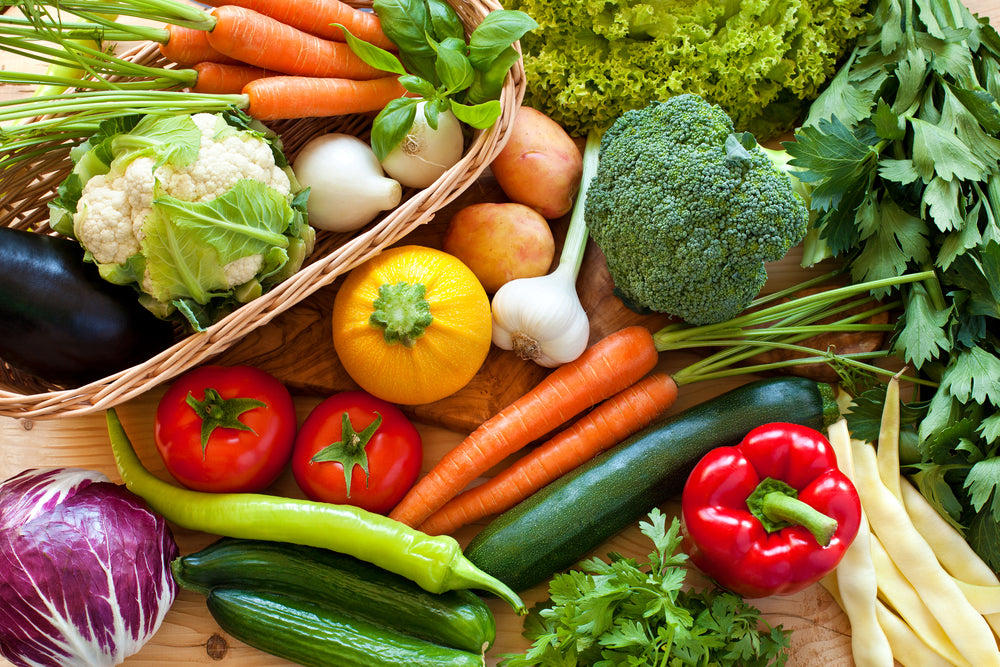
Cellulase is Essential for Digesting Fruits & Vegetables
Share
Chances are that if you’ve followed health news and statistics even a little, you know that eating more plant foods is probably the best way to improve your diet overnight, in particular, leafy green vegetables. This is because, in terms of nutrient intake, these are some of the best pound-for-pound foods around.1 While plants like kale and broccoli are a great addition to your diet, we don’t digest them in the same way we do other foods. As a result, to make sure all the nutrients are actually going where they need to go, cellulase is your best asset.
The Role of Cellulase
The major issue with plant foods is the cell wall, a fibrous complex that surrounds the plant cells. A major part of these cell walls is something called cellulose. Cellulase is an enzyme that is an essential part of digesting this plant fiber, but it’s not something that we naturally produce in our bodies. Other species that eat exclusively plants have means to get around this. For example, a cow has a four-chambered stomach, containing plenty of microbes that digest cellulose. This enables them to get virtually all the energy they need from eating plants.
For humans and other omnivorous creatures, we don’t have that advantage. Instead, we have to rely on our gut to help get the most out of our plant foods. Some plant fibers are fermented and digested in the large intestine, while others are eliminated from the body, and cellulase is essential to digesting the fibers. It helps convert cellulose into beta-glucose, one of the most fundamental forms of energy in the body.2
Another interesting fact about cellulase is that due to its ability to break down cellulose, it has potential roles outside of human health as well. Several industries, from textiles to agriculture and biofuel production, make use of these and other microbial enzymes.3
Benefits and Sources of Cellulase
We’ve established that you need cellulase in order to maximize digestion of your fruits and vegetables, but if we don’t produce it like other enzymes, how do we get it? The good news is that other organisms do produce cellulase naturally, like some symbiotic fungi, protozoa and bacteria. Many of these are contained in different types of plant food as well. It’s important to note that cellulase, in this case, isn’t a single enzyme. In reality, there are many different types of cellulase that operate at different levels of pH. One form may work better in a more acidic environment, while another may perform better in a more alkaline one.
The primary function of cellulase is to ensure that we are able to digest the cellulose fiber from plant foods, but there may be other potential benefits it offers as well. In one study of nursing-home patients, it was shown that taking a multi-enzyme formula containing cellulase led to improved protein absorption, as well as immune system support.4
With cellulase having a variety of benefits for the body, it’s important that you work not only to get a proper amount, but also to get the enzymes and nutrients that complement it. An ideal way to do that is with dietary supplements that use various enzymes in a proper formulated blend. A good example of this is Enzymedica’s Candidase Extra Strength. Along with cellulase, this has protease, probiotics and essential oils, to maintain bacterial balance in the small intestine. Because digestion of foods that contain cellulase can be inconsistent for many people, supplementation may help.
We are learning more and more about gut health and how it is a precursor not only to digestive health, but also to health in general.5 The hottest product in this category is probiotics, and while probiotics are indeed helpful, you don’t want to just stop there. Make sure that you are getting proper enzymes as well, to create the best digestive environment for plant foods, and for any other foods.
1. Tarwadi K, Agte V. Potential of commonly consumed green leafy vegetables for their antioxidant capacity and its linkage with the micronutrient profile. Int J Food Sci Nutr. 2003;54(6):417-25.
2. Abeles FB. Abscission: role of cellulase. Plant Physiol. 1969;44(3):447-52.
3. Kuhad RC, Gupta R, Singh A. Microbial cellulases and their industrial applications. Enzyme Res. 2011;2011:280696.
4. Glade MJ, Kendra D, Kaminski MV Jr. Improvement in protein utilization in nursing-home patients on tube feeding supplemented with an enzyme product derived from Aspergillus niger and bromelain. Nutrition. 2001 Apr;17(4):348-50.
5. Zhang YJ, Li S, Gan RY, Zhou T, Xu DP, Li HB. Impacts of gut bacteria on human health and diseases. Int J Mol Sci. 2015;16(4):7493-519.

